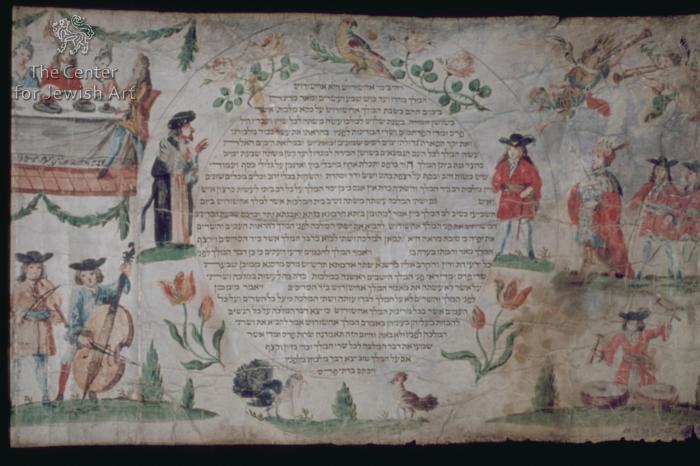Img. ID: 5270

Sheet no. 1
The first roundel is decorated with figures of a man - possibly Haman (on the right) - and Mordecai (on the left), birds, roses and tulips.
On the right, it is flanked by King Ahasuerus attended by his servants and two angels blowing trumpets are above them. Below them, two drummers can be seen.
On the left, there are men and women seated at a long table set with food - possibly depicting both feasts given by King Ahasuerus (Es. 1:3-8) and Queen Vashti (Es. 1:9). Below them are musicians playing string instruments. Both depictions are partly visible in the image.
F | Flower
A | Angel , (Sandalfon (angel)), (Metatron (angel))
M | Musician
E | Esther, Book of (following the order of the story) | Ahasuerus' banquet (Es. 1:3-8)
E | Esther, Book of (following the order of the story) | Vashti's banquet (Es. 1:9)
E | Esther, Book of (following the order of the story) | *Esther's Story Characters (depicted not in narrative scenes): | Ahasuerus, the king
E | Esther, Book of (following the order of the story) | *Esther's Story Characters (depicted not in narrative scenes): | Mordecai, the Jew
E | Esther, Book of (following the order of the story) | *Esther's Story Characters (depicted not in narrative scenes): | Haman, the vizier
F | Flower | Rose
| (?)
The scroll is preserved in good condition, although its final part is damaged - the membrane is crumpled and the decorations are slightly visible.
The Book of Esther in Hebrew
The scroll is formed of 4 sheets, in total containing 12 columns of text with 23-26 lines of different lengths, except for col. 10 which has 11 lines divided into two half-columns.
The number of columns of text per sheet: no. 1 - 2, nos. 2 and 3 - 3, no. 4 - 4.
The text is written in Hebrew square Ashkenazi script in dark brown-black ink on parchment membranes.
The letters ח (Es. 1:6) and ת (Es. 9:29) and the letters of the name of God are enlarged and bolded. Other enlarged and diminished letters are included in col. 10.
There are some corrections and erasures in the text.
The ruling is invisible.
The pricking on the membranes' edges can be seen.
The membranes of the scroll are glued together.
It seems that this scroll and two other scrolls featuring the same style (see "Related objects) were executed by the same artist, although two of them are decorated with roundels while the third one is decorated with octagons.
The Jewish World 365 Days, from the Collections of The Israel Museum, Jerusalem, New York 2004, 182-183.



